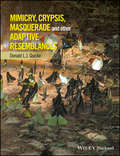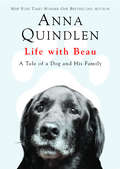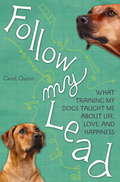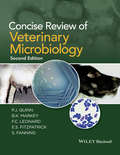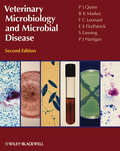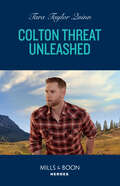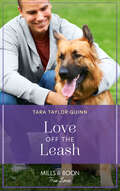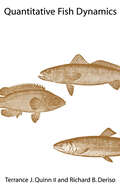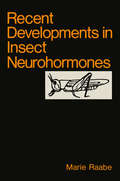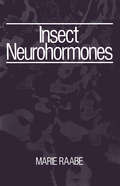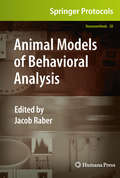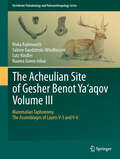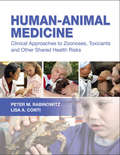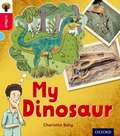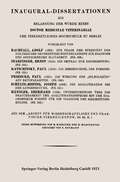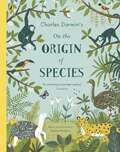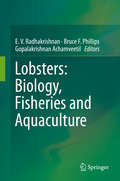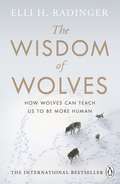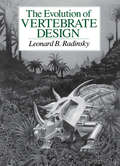- Table View
- List View
Mimicry, Crypsis, Masquerade and other Adaptive Resemblances: The Ecology And Evolution Of Adaptive Resemblance
by Donald L. QuickeDeals with all aspects of adaptive resemblance Full colour Covers everything from classic examples of Batesian, Mullerian, aggressive and sexual mimicries through to human behavioural and microbial molecular deceptions Highlights areas where additonal work or specific exeprimentation could be fruitful Includes, animals, plants, micro-organisms and humans
Life with Beau: A Tale of a Dog and His Family
by Anna QuindlenWhat started as an ode to Quindlen's aging black Labrador in her Newsweek column has become a life-affirming short book about happiness, in the tradition of A SHORT GUIDE TO A HAPPY LIFE and BEING PERFECT. In this wise little book, Anna Quindlen writes: "The life of a good dog is like the life of a good person, only shorter, more compressed." Quindlen continues, with her trademark wonderful writing, sound wisdom and humor, to explain how her life has unfolded in tandem with Beau, and how she's learned how to enjoy life, in the simplest of ways, by watching him. She writes, "When I was a mixed-breed puppy, I could never have imagined how simple and basic contentment could be. And that's what I've learned from watching Beau: to roll with the punches, to take things as they come, to measure myself not in terms of the past or the future but of the present, to raise my nose in the air from time to time and, at least metaphorically, holler, "I smell bacon!"
Follow My Lead: What Training My Dogs Taught Me about Life, Love, and Happiness
by Carol QuinnFollow My Lead is the story of how two rambunctious dogs and a tough Eastern European dog trainer named Irina taught Carol Quinn everything she needed to know about life, love, and happiness. It all begins when the author-unhappy with her failing love affair, her career, and even herself-decides to enroll her two Rhodesian ridgebacks into dog agility training. She's hoping to both find a hobby and straighten out her unruly pets, but she soon discovers that dog agility demands more from her than she ever expected. What follows is a life-changing experience: one that teaches her not only about her dogs but also about herself. With Irina’s guidance and wisdom, Quinn and her dogs develop a deep bond of trust as they learn to navigate the course obstacles, and Quinn begins to accept her own flaws, allowing her to find the inner strength to become the "alpha dog” of her own life.
Concise Review of Veterinary Microbiology
by P. J. Quinn B. K. Markey F. C. Leonard E. S. Fitzpatrick S. FanningUpdated to reflect the latest developments in the field, Concise Review of Veterinary Microbiology, 2nd Edition, presents essential information on veterinary microbiology for students and those requiring a refresher on key topics relating to microbial diseases in animals. Morphological, cultural and other descriptive features of pathogenic microorganisms are described, together with their habitats and aetiological roles in disease production in animals and, where appropriate, in the human population. Key features:• There are five sections covering bacteriology, mycology, virology, biosecurity and other aspects of infectious diseases• Provides concise, yet comprehensive information on pathogenic microorganisms of importance in veterinary medicine, the diseases which they cause, their diagnosis and control• The 79 short chapters in this book include 13 new chapters on antibacterial resistance, structure and function of the immune system, antifungal chemotherapy, antiviral chemotherapy, principles of biosecurity and a number of topics related to the control and prevention of infectious diseases• This latest edition uses updated nomenclature and includes detailed diagrams now in full colour, and comprehensive tables
Concise Review of Veterinary Microbiology
by P. J. Quinn B. K. Markey F. C. Leonard E. S. Fitzpatrick S. FanningUpdated to reflect the latest developments in the field, Concise Review of Veterinary Microbiology, 2nd Edition, presents essential information on veterinary microbiology for students and those requiring a refresher on key topics relating to microbial diseases in animals. Morphological, cultural and other descriptive features of pathogenic microorganisms are described, together with their habitats and aetiological roles in disease production in animals and, where appropriate, in the human population. Key features:• There are five sections covering bacteriology, mycology, virology, biosecurity and other aspects of infectious diseases• Provides concise, yet comprehensive information on pathogenic microorganisms of importance in veterinary medicine, the diseases which they cause, their diagnosis and control• The 79 short chapters in this book include 13 new chapters on antibacterial resistance, structure and function of the immune system, antifungal chemotherapy, antiviral chemotherapy, principles of biosecurity and a number of topics related to the control and prevention of infectious diseases• This latest edition uses updated nomenclature and includes detailed diagrams now in full colour, and comprehensive tables
Veterinary Microbiology and Microbial Disease
by P. J. Quinn B. K. Markey F. C. Leonard P. Hartigan S. Fanning E. S. FitzpatrickMicrobiology is one of the core subjects for veterinary students, and since its first publication in 2002, Veterinary Microbiology and Microbial Disease has become an essential text for students of veterinary medicine. Fully revised and expanded, this new edition updates the subject for pre-clinical and clinical veterinary students in a comprehensive manner. Individual sections deal with bacteriology, mycology and virology. Written by an academic team with many years of teaching experience, the book provides concise descriptions of groups of microorganisms and the diseases which they cause. Microbial pathogens are discussed in separate chapters which provide information on the more important features of each microorganism and its role in the pathogenesis of diseases of animals. The international and public health significance of these pathogens are reviewed comprehensively. The final section is concerned with the host and is organized according to the body system affected. Tables, boxes and flow diagrams provide information in an easily assimilated format. This edition contains new chapters on molecular diagnostics and on infectious conditions of the skin, cardiovascular system, urinary tract and musculoskeletal system. Many new colour diagrams are incorporated into this edition and each chapter has been updated. Key features of this edition: Twelve new chapters included Numerous new illustrations Each chapter has been updated Completely re-designed in full colour Fulfils the needs of veterinary students and academics in veterinary microbiology Companion website with figures from the book as Powerpoints for viewing or downloading by chapter: www.wiley.com/go/quinn/veterinarymicrobiology Veterinary Microbiology and Microbial Disease remains indispensable for all those studying and teaching this essential component of the veterinary curriculum.
Veterinary Microbiology and Microbial Disease
by P. J. Quinn B. K. Markey F. C. Leonard P. Hartigan S. Fanning E. S. FitzpatrickMicrobiology is one of the core subjects for veterinary students, and since its first publication in 2002, Veterinary Microbiology and Microbial Disease has become an essential text for students of veterinary medicine. Fully revised and expanded, this new edition updates the subject for pre-clinical and clinical veterinary students in a comprehensive manner. Individual sections deal with bacteriology, mycology and virology. Written by an academic team with many years of teaching experience, the book provides concise descriptions of groups of microorganisms and the diseases which they cause. Microbial pathogens are discussed in separate chapters which provide information on the more important features of each microorganism and its role in the pathogenesis of diseases of animals. The international and public health significance of these pathogens are reviewed comprehensively. The final section is concerned with the host and is organized according to the body system affected. Tables, boxes and flow diagrams provide information in an easily assimilated format. This edition contains new chapters on molecular diagnostics and on infectious conditions of the skin, cardiovascular system, urinary tract and musculoskeletal system. Many new colour diagrams are incorporated into this edition and each chapter has been updated. Key features of this edition: Twelve new chapters included Numerous new illustrations Each chapter has been updated Completely re-designed in full colour Fulfils the needs of veterinary students and academics in veterinary microbiology Companion website with figures from the book as Powerpoints for viewing or downloading by chapter: www.wiley.com/go/quinn/veterinarymicrobiology Veterinary Microbiology and Microbial Disease remains indispensable for all those studying and teaching this essential component of the veterinary curriculum.
Colton Threat Unleashed (The Coltons of Owl Creek #1)
by Tara Taylor QuinnThey must work together…forever
Quantitative Fish Dynamics (Biological Resource Management)
by Terrance J. Quinn Richard B. DerisoThis book serves as an advanced text on fisheries and fishery population dynamics and as a reference for fisheries scientists. It provides a thorough treatment of contemporary topics in quantitative fisheries science and emphasizes the link between biology and theory by explaining the assumptions inherent in the quantitative methods. The analytical methods are accessible to a wide range of biologists, and the book includes numerous examples. The book is unique in covering such advanced topics as optimal harvesting, migratory stocks, age-structured models, and size models.
Quantitative Fish Dynamics (Biological Resource Management)
by Terrance J. Quinn Richard B. DerisoThis book serves as an advanced text on fisheries and fishery population dynamics and as a reference for fisheries scientists. It provides a thorough treatment of contemporary topics in quantitative fisheries science and emphasizes the link between biology and theory by explaining the assumptions inherent in the quantitative methods. The analytical methods are accessible to a wide range of biologists, and the book includes numerous examples. The book is unique in covering such advanced topics as optimal harvesting, migratory stocks, age-structured models, and size models.
Recent Developments in Insect Neurohormones
by M. RaabeThe most striking fact revealed by investigations of insect neurohormones is that insects are as well supplied with neurohormones as mammals, since neurohor mones regulate not only the functioning of the endocrine glands, prothoracic gland, and corpora allata, but also most physiological processes. Our knowledge of neurohormones developed originally from anat omocytological investigations and experimental studies. Today, accurate bio assays have been devised for studying both in vivo and in vitro physiological processes, and RIA determination has yielded knowledge of titer modifications of humoral factors. Much is also known about neurohormone purification, and several neurohormones have even been identified in different species. Immunocytochemistry has made it possible to demonstrate in their origin and release sites the presence of insect neurohormones whose structure has been elucidated. Moreover, the presence of vertebrate and invertebrate neuropeptides has been demonstrated in insects. As regards biogenic amines, methods of detection have been greatly refined and it is now possible to identify the cell bodies and axons of the main biogenic amines. Other new methods, such as cobalt chloride impregnation or Lucifer yellow staining, have revealed the axonal pathways and the location of particular neurons. The mechanisms of action of neurohormones have been investigated in several cases and the results of these investigations will be related in the chapters which follow.
Insect Neurohormones
by Marie RaabeThe discovery of insect neurohormones dates from the earliest experimental in vestigations in insect endocrines, and the matter cannot be discussed without evoking the names of its pioneers-Kopec, Wigglesworth, Fraenkel. Whereas the experiments demonstrated the existence of the first known neurohormones, the formulation of the concept of neurosecretion was of fundamental importance to further progress, and tribute must be paid to Ernst and Berta Scharrer. The recent proliferation of investigations into insect neurohormones has cre ated the need for an overall review of the data. Our knowledge of the subject is voluminous, and the evidence clearly demonstrates that neurohormones playa part in most insect regulatory processes. This book analyzes and synthesizes the data, starting from neurosecretion (i.e., source sites and release modes of neurohormones) and continuing through the various functions in which neurohormones have been shown to be involved: endocrine gland activity; diapause; reproduction; visceral muscle functioning; color change; behavior; water and ion balance; protein, sugar, and lipid metabo lism; and tanning and other processes occurring at the cuticle level. In each chapter, besides the experimental information, technical procedures as well as recent information concerning purification of the particular neurohor mones and their mode of action are reported. Numerous exhaustive tables allow the reader to get an overview of the matter while the major findings of the mo ment are presented in the conclusion of each chapter.
Animal Models of Behavioral Analysis (Neuromethods #50)
by Jacob RaberDespite the difficulty in comparing clinic-based human tests with animal model testing, there is still great value in pursuing translational approaches, as tests and treatment strategies might be developed to improve brain function in humans suffering from neurological conditions and knowledge obtained from human behavioral studies can be used to further improve the animal models of behavioral analysis. In Animal Models of Behavioral Analysis, expert neuroscientists focus on approaches to translate and compare behavioral tests used in animals with those used in humans not only to increase our understanding of brain function across species but also to provide objective performance measures and bridge the gap between behavioral alterations in humans with cognitive disorders and the correlating animal models of these conditions. Written in the Neuromethods series format, the chapters provide authoritative reviews of many commonly used approaches in the field today. Provocative and cutting-edge, Animal Models of Behavioral Analysis seeks to aid researchers in further developing these vital techniques in an effort to advance studies in both the clinic and the laboratory.
The Acheulian Site of Gesher Benot Ya‘aqov Volume III: Mammalian Taphonomy. The Assemblages of Layers V-5 and V-6 (Vertebrate Paleobiology and Paleoanthropology)
by Rivka Rabinovich Sabine Gaudzinski-Windheuser Lutz Kindler Naama Goren-InbarMultidisciplinary research on the Early-Middle Pleistocene site of Gesher Benot Ya‘aqov has yielded abundant climatic, environmental, ecological and behavioral records. The 15 archaeological horizons form a sequence of Acheulian occupational episodes on the shore of the paleo-Lake Hula. These enable us to reconstruct numerous aspects of the survival and adaptation of ancient hominins, leading to a better understanding of their evolution and behavior. This book presents the faunal analyses of medium-sized and large mammals, providing taxonomic, taphonomic and actualistic data for the largest faunal assemblages. The study of modes of animal exploitation reveals valuable information on hominin behavior.
Human-Animal Medicine - E-Book: Clinical Approaches to Zoonoses, Toxicants and Other Shared Health Risks
by Peter M. Rabinowitz Lisa A. ContiHuman-Animal Medicine is an innovative reference exploring the unprecedented convergence of human, animal, and environmental health, triggering global pandemics and requiring new clinical paradigms. The "One Health" approach calls for greater communication and cooperation between human health care providers, public health professionals, and veterinarians to better address vital issues of emerging diseases and environmental change. This incredibly timely book provides, for the first time, practical guidelines for "One Health" collaborations in a wide range of clinical human-animal health issues, including the H1N1 virus, zoonotic diseases, the human-animal bond, animal allergy, bites and stings, and animals as "sentinels" for toxic environmental health hazards. UNIQUE! For each condition, specific steps human health care providers, veterinarians, and public health professionals must take to prevent and manage disease. UNIQUE! Comparative tables of disease signs, diagnosis and treatment in humans and animals for easy reference. UNIQUE! Guidelines to detect and improve environmental factors affecting the health of humans and animals. Occupational health guidelines for preventive care of animal workers including veterinary personnel, farmers, pet store employees, and zoo workers. Treatment of emerging disease issues including zoonoses, H1N1 virus, harmful algae blooms, and animal-related pesticides UNIQUE! Sample protocols facilitate professional communication between veterinarians, human health clinicians, and public health professionals. Legal and ethical aspects of "One Health" that human health providers and veterinarians need to know.
Oxford Reading Tree inFact: Oxford Level 4: My Dinosaur
by Charlotte RabyMeet Diego and the dinosaur he discovered! This true story of a boy who found a dinosaur skeleton will intrigue and inspire readers. Oxford Reading Tree inFact is a series of engaging and imaginative non-fiction books which encourage reading for pleasure and are also phonically decodable.
Zur Frage der Spezifität des Noltzeschen Sedimentierungsverfahrens zur Diagnose der ansteckenden Blutarmut
by Adolf RachfallDieser Buchtitel ist Teil des Digitalisierungsprojekts Springer Book Archives mit Publikationen, die seit den Anfängen des Verlags von 1842 erschienen sind. Der Verlag stellt mit diesem Archiv Quellen für die historische wie auch die disziplingeschichtliche Forschung zur Verfügung, die jeweils im historischen Kontext betrachtet werden müssen. Dieser Titel erschien in der Zeit vor 1945 und wird daher in seiner zeittypischen politisch-ideologischen Ausrichtung vom Verlag nicht beworben.
On The Origin of Species: Or The Preservation Of Favoured Races In The Struggle For Life
by Sabina RadevaThe first ever picture-book retelling of Charles Darwin's On The Origin of Species; this accessible work brings evolution to the younger generation through stylish illustrations and a simple, easy-to-understand text.On The Origin of Species has been the definitive explanation of the theory of evolution since it was first published in 1859. Now molecular biologist and illustrator Sabina Radeva unites her two passions to create a 48-page retelling of this seminal text.Pulling together Darwin's observations from his travels around the world and his groundbreaking - and controversial - explanation of how species form, develop and change over hundreds of thousands of years, On The Origin of Species is as relevant and important now as it ever was.
Lobsters: Biology, Fisheries and Aquaculture
by E. V. Radhakrishnan Bruce F. Phillips Gopalakrishnan AchamveetilThis book is an important addition to the knowledge of lobster research. The book complements other books published on lobster research and management as it focuses on Indian lobster fisheries and aquaculture developments where there have been nearly 350 research papers and reports and 19 PhD awards. The book has 15 chapters written by international experts covering many aspects of the biology of a number of spiny and slipper lobster species occurring in India and world oceans with maps illustrating global distribution of spiny lobster families, genera and species. An updated taxonomy and checklist of marine lobsters, the status and management of lobster fisheries in India and Indian Ocean Rim countries and a review of aquaculture research in India and other major countries have also been presented. The book is timely as the 2nd International Indian Ocean Expedition (IIOE) is currently underway (2015-2020), 50 years after the original IIOE (1959-1965), with some of the original lobster research on the biology and distribution of phyllosoma larvae being undertaken on the plankton samples collected during the first IIOE. Many of the chapters are contributed by the authors from Central Marine Fisheries Research Institute (CMFRI), which has been collecting fishery and biological data on lobsters since 1950 when lobster fishing began on a subsistence scale, followed by some industrial fishing for lobsters in different parts of India. Unfortunately, the development of some of these lobster fisheries was followed by overfishing due to lack of enforcement of regulations. The book provides a valuable addition to our knowledge of the biology, fisheries and aquaculture of spiny and slipper lobsters.
The Wisdom of Wolves: Understand How Wolves Can Teach Us To Be More Human
by Elli H. Radinger'Enchanting' Mail on Sunday They care for their elderly, play with their kids, and always put family first. Can we all learn something from the wisdom of wolves? In this unforgettable book, wolf expert and naturalist Elli Radinger draws on her 25 years of first-hand experience among the wolves of Yellowstone National Park to tell us their remarkable stories.__________Wolves aren't wolfish. They can die of broken hearts, show tenderness to their young and elderly, and their packs are led by couples, with the key decisions made by females. They play, they pretend and they predate. They are more complex than we ever knew and more like us than we ever imagined. You'll meet Oh-Six, the she-wolf whose bold hunting technique astounded the most experienced biologists, Casanova who succeeded in luring his love away from her pack, and Druid alpha male 21, the magnanimous and compassionate leader.Ultimately, Radinger shows how much we can learn from these beautiful and mysterious creatures, and how much there is to gain from emulating the wisdom of wolves.'This book is the result of her two decades of close observation; part impassioned memoir, part natural history study, and part photo gallery. Her access to her subjects is extraordinary' Sunday Times
Evolution of Vertebrate Design
by Leonard B. RadinskyThe Evolution of Vertebrate Design is a solid introduction to vertebrate evolution, paleontology, vertebrate biology, and functional, comparative anatomy. Its lucid style also makes it ideal for general readers intrigued by fossil history. Clearly drawn diagrams illustrate biomechanical explanations of the evolution of fins, jaws, joints, and body shapes among vertebrates. A glossary of terms is included. "A luminous text is matched by lucid drawings rationally placed. . . . A great teaching monograph, the book will charm lay readers of fossil history. For virtually every college & public collection."—Scitech Book News
Evolution of Vertebrate Design
by Leonard B. RadinskyThe Evolution of Vertebrate Design is a solid introduction to vertebrate evolution, paleontology, vertebrate biology, and functional, comparative anatomy. Its lucid style also makes it ideal for general readers intrigued by fossil history. Clearly drawn diagrams illustrate biomechanical explanations of the evolution of fins, jaws, joints, and body shapes among vertebrates. A glossary of terms is included. "A luminous text is matched by lucid drawings rationally placed. . . . A great teaching monograph, the book will charm lay readers of fossil history. For virtually every college & public collection."—Scitech Book News
Evolution of Vertebrate Design
by Leonard B. RadinskyThe Evolution of Vertebrate Design is a solid introduction to vertebrate evolution, paleontology, vertebrate biology, and functional, comparative anatomy. Its lucid style also makes it ideal for general readers intrigued by fossil history. Clearly drawn diagrams illustrate biomechanical explanations of the evolution of fins, jaws, joints, and body shapes among vertebrates. A glossary of terms is included. "A luminous text is matched by lucid drawings rationally placed. . . . A great teaching monograph, the book will charm lay readers of fossil history. For virtually every college & public collection."—Scitech Book News
Evolution of Vertebrate Design
by Leonard B. RadinskyThe Evolution of Vertebrate Design is a solid introduction to vertebrate evolution, paleontology, vertebrate biology, and functional, comparative anatomy. Its lucid style also makes it ideal for general readers intrigued by fossil history. Clearly drawn diagrams illustrate biomechanical explanations of the evolution of fins, jaws, joints, and body shapes among vertebrates. A glossary of terms is included. "A luminous text is matched by lucid drawings rationally placed. . . . A great teaching monograph, the book will charm lay readers of fossil history. For virtually every college & public collection."—Scitech Book News
